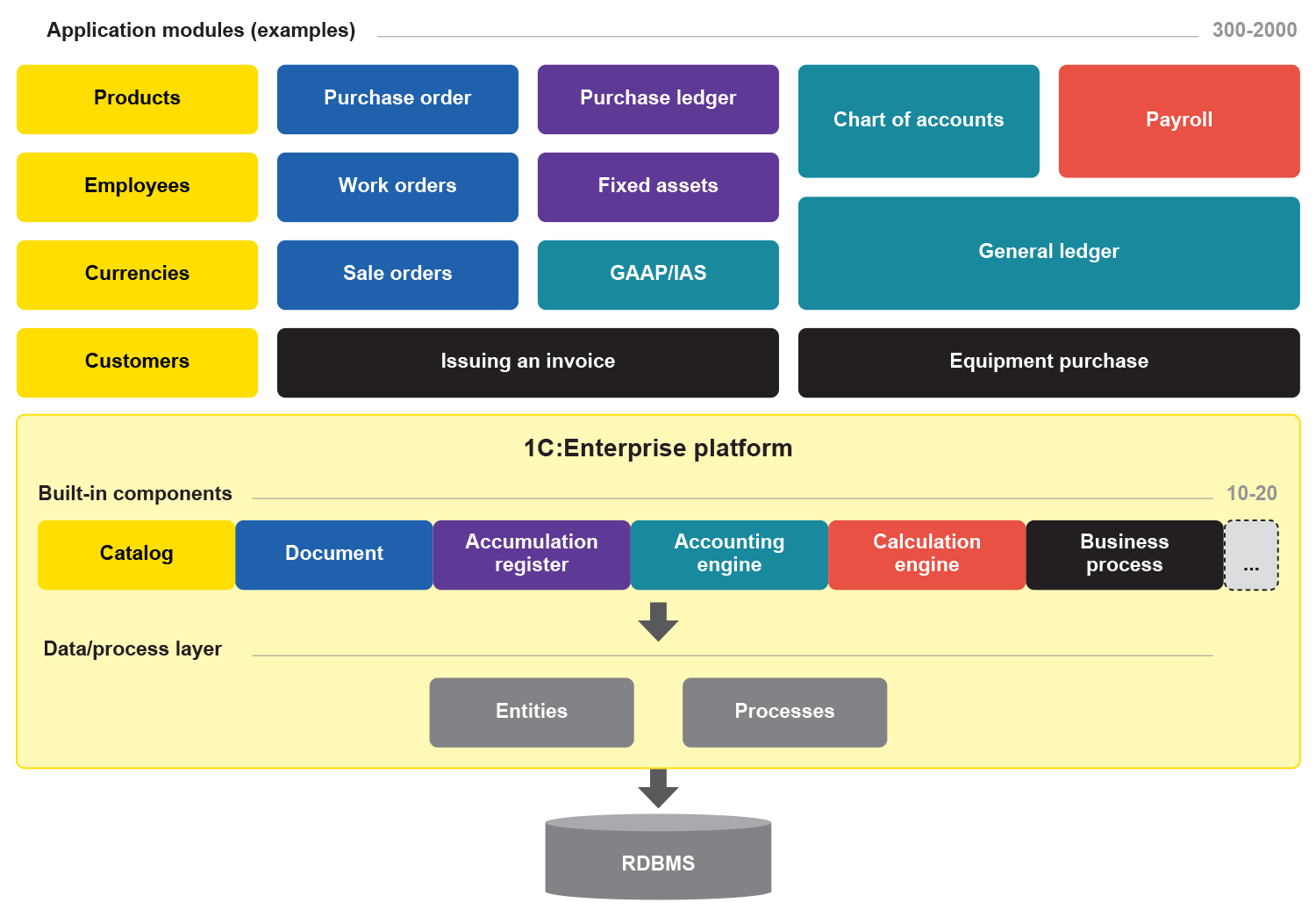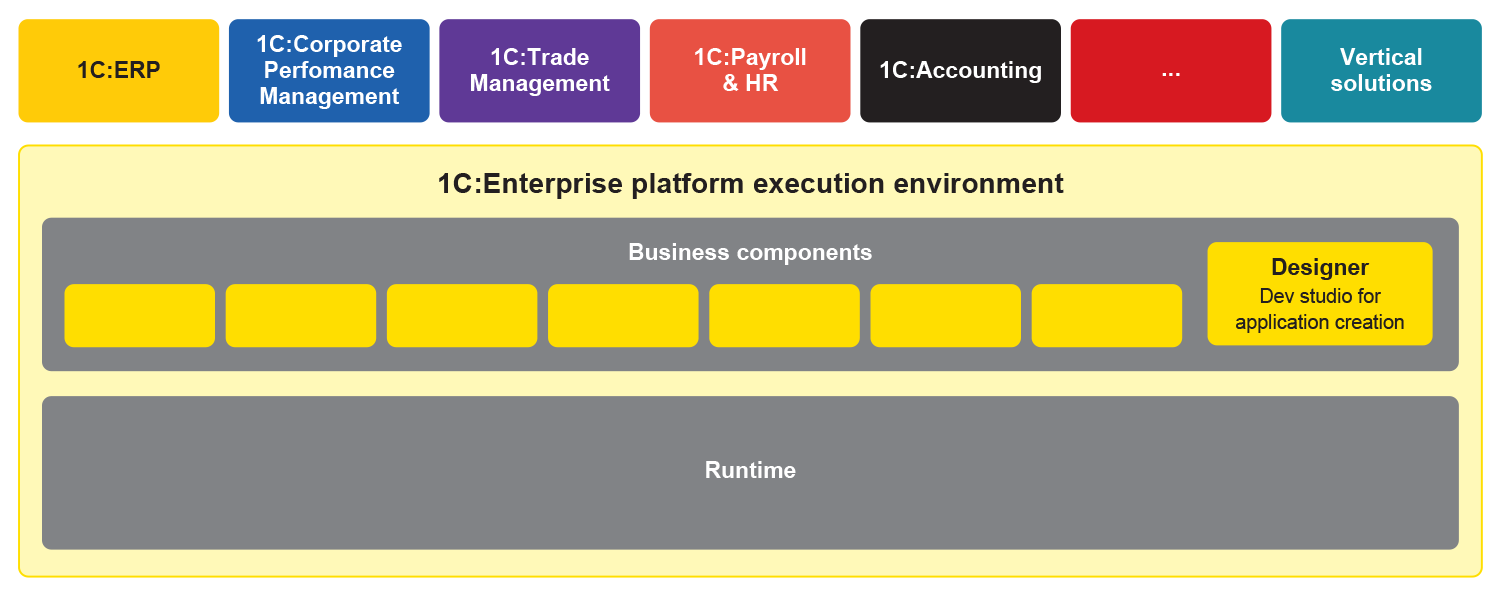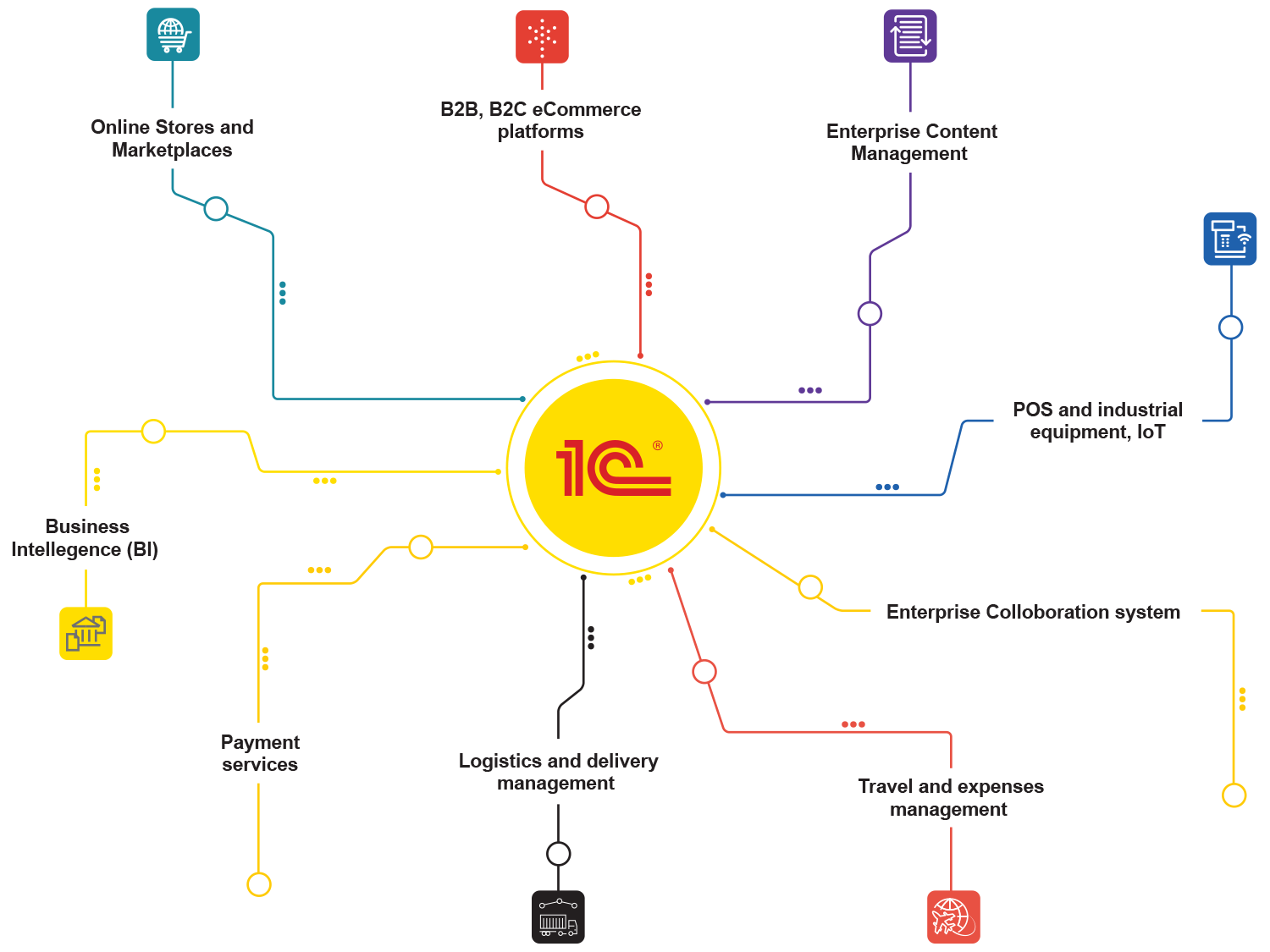
The 1C:Enterprise platform is an incredible tool to efficiently create software for managing business functions covering finances, manufacturing, administrative tasks, payroll, sales, and more. The role of such software is to:
- collect, store and process data;
- automate business processes;
- ensure compliance with regulatory requirements;
- facilitate management decisions by providing immediate access to accurate information on company assets and operations.
Examples of such software are ERP, EAM, CRM, CPM, WMS, and similar solutions, jointly known as core systems or systems of record (SORs). Employees in warehouses, sales, logistics, and other departments, enter data into the software. Using this data, the software can support processes on various levels, from a single department to a group of departments or even on a company-wide level.
The essential advantage of the 1C:Enterprise platform is that the basic functionality of SORs is integrated, and developers get it out of the box. It allows developers to build applications much faster compared to a traditional approach where they have to do the job from scratch.
Contents:
Building management, accounting, inventory tracking applications
A system of applications
Mobile applications
Integration
Continuous improvement
Ready-made 1C software products as the basis for developing local and niche solutions
Conclusion
Building Management, Accounting, and Inventory Tracking Applications
The concept of creating applications on the 1C:Enterprise platform treats the essential SOR functions as building blocks similar to a LEGO set. Developers use these blocks to put together an application structure and then append it with specific algorithms to let the application operate as required by the business logic of a specific company. Then the platform, utilizing this business logic, automatically generates a user interface for data entry and editing; plus, it creates a backend to interact with databases and the operating system.
| Read more on Creating Business Applications: 1C:Enterprise vs. Traditional Development |
The platform components are objects and engines (or mechanisms). Some of them describe business functions, while others stand on the technology side. Business components include catalogs, documents, reports, accumulation registers, calculation registers, the accounting engine, the chart of characteristics, the chart of accounts, business processes, and others. Technology components include web and HTTP services, data access, support for background processes and tasks, data history, full-text search, and others.
Catalogs, documents, and reports are good examples to describe the role of platform objects.
Catalogs are lists that contain products, customers, currencies, and similar.
Documents log all the events that occur as a company runs its operations, like receipt of materials, money transfer, hiring of an employee, and similar.
For example, a user adds a new product to catalog Products and then retrieves this data in the process of the product sale. To create a sale transaction, such user creates a new document and describes its content by adding information from specific catalogs prefilled by the user or somebody else. The user picks a client from the catalog Clients, a product from catalog Products, a warehouse from catalog Warehouses, and so on.
Reports process and present data stored in the system. With this ready-to-use component, end users can build complex drill-down reports.
In addition to objects, the platform offers many mechanisms for handling typical business tasks. Here are some of them:
Asset tracking engine is designed to handle tasks related to managing tangible assets, automation of planning processes, warehouse inventory control, and netting of payables and receivables.
Complex periodic calculations engine is a versatile tool for calculating salaries and wages, dividends, utility costs, and similar.
Accounting engine is a versatile tool designed to automate accounting processes under various accounting models.
While the platform mechanisms interact with each other, they also rely on the platform objects. For example, the accounting engine relies on such objects as the chart of accounts, the chart of characteristic types, and accounting registers. Such interaction of components produces an aggregate effect and makes up a consistent model where all elements complement each other.

The diagram shows some of the platform’s business components and application modules that can be built with these business components. Related application modules and the platform’s business components are marked with identical colors.
The selection of components offered by the platform is sufficient to cover most of the day-to-day tasks of businesses, namely:
- financial planning and analysis;
- accounting, closing, tax management, and compliance;
- accounts payable and receivable;
- treasury and cash management;
- human resources management and payroll;
- inventory management and tracking;
- document management;
- manufacturing;
- and others.
A System of Applications
According to analysts, future ERP systems will represent a set of applications that can be rearranged and repackaged to fit changing business requirements. Unlike traditional monolithic ERPs that take years to implement and weeks to introduce even minor adjustments, the strategy of composite ERP systems makes it possible to quickly implement the required functionality into an individual application and then integrate this application into the system.
Also, this future-oriented approach gives way to achieving greater development and implementation flexibility through composing a system out of applications by different vendors. At that, such applications allow hybrid, on-premise, or cloud deployment. For example, HCM, CRM, or supply chain functionality that comes with an ERP system can be substituted with a custom product designed specifically for the respective functional area.
This paradigm requires a unified data model where development efforts can concentrate on business logic instead of the never-ending conversion of data to migrate it between applications. Thanks to the 1C:Enterprise platform, developers can easily reach the goal by quickly integrating platform-based applications into a unified system.
In the 1C ecosystem, by model, we mean the whole ideology of building applications. It includes methods to build data structures, types of relationships between data, principles of data handling, ways to describe business logic, rules for linking data with interface objects, approaches to separating functionality on system levels, and much more.
As a result, all components of the unified system based on the 1C:Enterprise platform fully comply with the model that ensures applications uniformity, predictable behavior, and ability to operate as one system.

| Read more on The Way We Handle Data Models in 1C Enterprise or “Why Avoid Tables?” |
Mobile Applications
The ability to work from anywhere is becoming increasingly popular. If earlier corporate mobile applications were relevant mainly for employees in the fields, now the ability to work from a mobile device for everybody has become mainstream. The 1C:Enterprise platform offers a set of dedicated technologies to enable users to access 1C:Enterprise-based corporate systems with mobile devices.
Thus, mobile clients grant users access to all functions in online mode while offline mode provides limited functionality with synchronization of data when the Internet is available.
Besides, developers can create a standalone mobile application using the mobile platform included with the distribution of the 1C:Enterprise platform. Standalone mobile applications are ideal for organizing employees’ work in fields where reliable data connection might be an issue. Also, it is a marvelous solution for consumer applications. The mobile platform utilizes the same development principles as the main 1C:Enterprise platform.
| Read more on Enabling a Mobile Workforce. Tips and Use-Cases and Enhance Your Back-Office Software Product with a Consumer Mobile Application |
Integration
Given the need for any business system to integrate into the existing ecosystem of company software products, the most important task of any software product is to provide for integration with systems from other vendors.
The platform supports integration with almost any external software and equipment by utilizing universally recognized open standards and data transfer protocols. The platform’s integration mechanisms include REST API, web and HTTP services, data exchange, and many others.

It is also vital that a product is able to absorb new technologies that can do the things the platform cannot. Extensive integration options allow using third-party systems and technologies in platform-based applications. For example, if you need machine learning, you can use Python and other technologies to handle ML tasks and retrieve the results to your application via HTTP or RabbitMQ protocol.
| Read more on How to Use Machine Learning in 1C solutions |
Continuous Improvement
In addition to functionality, user interface, and integration capabilities, the architecture of a software product must allow it to evolve and adapt to new conditions. The product must be flexible and able to adapt to individual customer current and future business needs.
To ensure better support for 1C:Enterprise-based products, the platform offers developers a specific built-in mechanism. We call it extensions. Basically, this is a plugin technology that makes it possible to add extensions without modifying core applications.
| Read more on How to Keep up with Ever-changing Demands for a Business Automation System and Still Maintain its Cost-effectiveness |
Ready-made 1C Software Products as the Basis for Developing Local and Niche Solutions
The 1C Company and its subsidiaries create versatile business products using the 1C:Enterprise platform. International market products include 1C:ERP WE, 1C:Document Management, and 1C:Drive. As these products are open-source code, developers can build their solutions on top of them.
With a 1C product as the basis for their own solution, developers can significantly reduce the time to develop and bring their product to the market.
| Read also Development of ERP solutions. Why 1C:Enterprise? |
Conclusion
To crown it all, I would like to emphasize that the 1C:Enterprise is a special-purpose platform that yields the maximum result when utilized for its intended purpose. The platform is your ultimate choice when you need to develop applications that handle business tasks involving finance, goods, materials, human resources, or customer relations and require
-
complex business logic;
-
clients for desktop, web, and mobile;
-
cross-platform compatibility (Windows, Linux, Mac, iOS, Android);
-
automatically generated customizable UI/UX and object-relational mapping;
-
flexible and deep analytical reporting tools;
-
role-based security system and flexible access rights;
-
fast prototyping and short time-to-market;
-
rich integration options (ODBC, REST API, SOA, web services, OData, XML, JSON, COM, SOAP, HTTP);
-
ability to make changes on the fly (without stopping the system);
-
standalone or client-server-based app.
Got interested? Start developing on the 1C:Enterprise platform for free today.
The article was renewed on October 12, 2022





